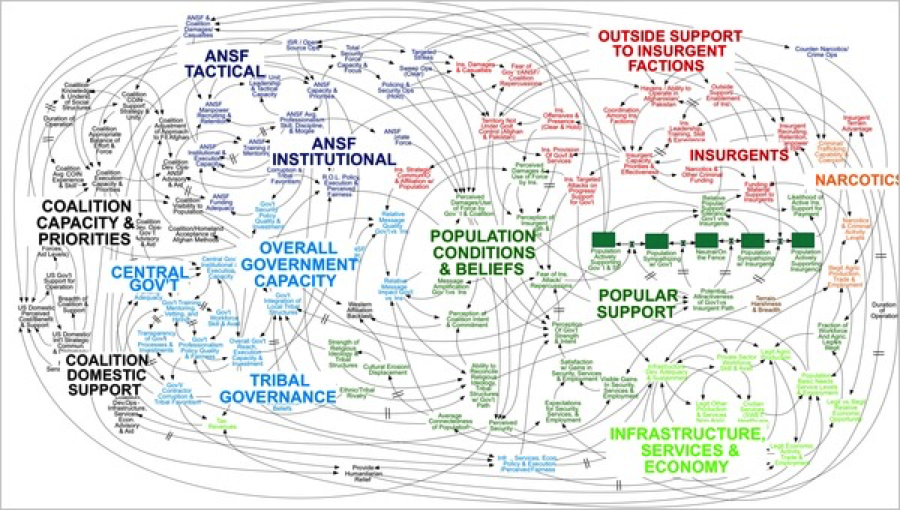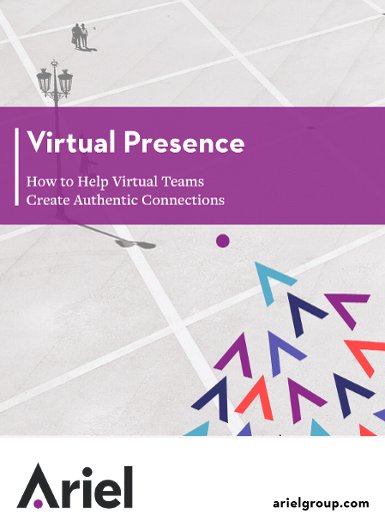Five Narratives That Move Organizations

The next time you are scheduled to run a town hall meeting, get buy-in for a new idea, or simply give a status update, I suggest holding off on creating a detailed chart or graph to insert into your PowerPoint.
In the summer of 2010 the now retired General Stanley A. McChrystal was Commander of the U.S. Forces in Afghanistan. One day, during an important briefing in Kabul, he was shown the following PowerPoint slide:
It was meant to represent the most current military strategy. Upon seeing the slide, General McChrystal interrupted the briefing and said: “When we understand that slide, we’ll have won the war.”
After the laughter died down he put aside the slide deck and then wanted to know only two things:
- What has changed since the last time we discussed the situation?
- What do you recommend we do about it?
Answering those two questions requires a coherent and persuasive narrative without relying heavily on charts and graphs to communicate the message—in other words, he wanted a story.
In my time coaching executives in the art and science of business storytelling over the last eighteen years, I’ve learned that certain types of stories are more compelling than others. In fact, I’ve concluded that there are fundamentally five basic narratives that every leader needs to be able to craft in order to move people to action:
- The who I am story
- The who we are story
- The what we have learned story
- The why we are changing story
- The how to see things differently to improve your life, work, and the world around you story
These are the stories that shape organizations. I’ll go through them one at a time.
The who I am story
At Ariel we teach that a leader’s job is to connect authentically with the hearts and minds of others in order to motivate and inspire them towards a desired outcome.
Warren Buffet, chairman and CEO of Berkshire Hathaway, believes this too. In an interview about leadership with John F. Harris of Politico he once said, “…people have to understand what you’re about. They may not always fully understand where you are going, but they have to believe in you.”
A well-crafted who I am story helps people believe in you by answering these important questions:
- How and why did you get to be a leader?
- What are your strengths? What are your limitations?
- What have you learned along the way?
- What do you stand for?
- Why do you stand for those things?
The who we are story
Once a leader has successfully shared their who I am story, their work isn’t done. The next step is to help the organization embrace who they are and who they are capable of becoming. What holds everyone together? What are the values of the company, team, or organization? Why should people want to be part of it?
A well-crafted who we are story helps create the conditions where people want to be engaged and participate in their organization. It taps into the basic human need that we all have to belong—to be part of something bigger than ourselves.
The what we have learned story
According to the Pew Research Center, 10,000 Baby Boomers will be retiring every single day for the next 11 years. That’s 51 million people. Additionally, the Social Security Administration has reported that almost 50% of those people are leaders in some capacity. This mass exodus of managers and supervisors is causing the largest leadership gap America has ever seen.
Organizations are deeply concerned about this “brain drain”—and about filling their leadership pipelines. One way to keep intellectual capital in an organization is to get very good at telling the what have we learned story.
This story imparts history and context for current decision making. It helps acculturate new employees, it quickly teaches health and safety policies, and most importantly, it passes wisdom on from one generation of leaders to the next.
The why we are changing story
My first boss used to say that the only person who likes a change is a wet baby. Considering that at the time he’d never even heard of a thing called email, it’s safe to say that change is an ongoing part of business—but that doesn’t make it easy.
The why are we changing story is the narrative that answers the questions people always have during times of complexity and transformation:
- What is the change?
- Why do we need to change?
- What will happen if we don’t change?
- How will the change help us make more money, improve our relationships, or improve our organization?
This type of story helps convince people that change is not only inevitable, but also essential to survival. It can also help to frame the change in a positive light, which research has shown is connected to success in change initiatives.
The how to see things differently to improve your life, work, and the world around you story
A core competency for a leader is the ability to dream—to set vision and to create strategy to achieve that dream. People and communities can achieve great things when they understand what success looks like, which is why the how to see things differently to improve your life, work, and the world around you story is perhaps the most important in a leader’s library.
In 1977 when Bill Gates first said he wanted his company to put a computer on every desk in every home, folks thought he was crazy. What would the average person do with a computer? Computers were for hobbyists. But his vision became a reality, in great part, because he articulated his story clearly, consistently, and with passion.
Try a story instead of a slide
The next time you are scheduled to run a town hall meeting, get buy-in for a new idea, or simply give a status update, I suggest holding off on creating a detailed chart or graph to insert into your PowerPoint. Instead, for greater impact, try crafting one of the five essential narratives to communicate your message.
As General McChrystal indicated, some ideas just weren’t made to be bulleted. Want to learn more? Contact us.
This blog was originally published April 1, 2015 and was updated February 15, 2018 for accuracy.

